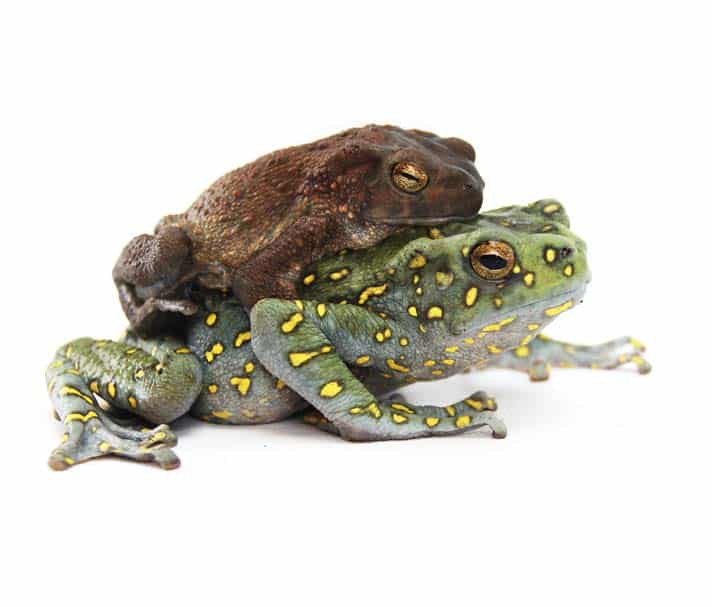These toads are hardy when captive bred, and as easy to keep as a White’s tree frog.
It was March of 2014. As often happens, I was on the road for work at a most inopportune time. A project we had been working on for years was on the verge of success, and I couldn’t be there for it. Fortunately, a fellow frogger I could count on — Austin Rea — was back at the breeding facility, monitoring things. The call came around lunchtime on Friday, while the Josh’s Frogs crew was setting up for the Tinley Park NARBC: Eggs! Thousands of eggs! We hadn’t won yet, but we were in the race!

Trish Eddie; Amanda Potter
A male yellow-spotted climbing toad.
The eggs in question belonged to the largest species of arboreal toad in existence, the yellow-spotted climbing toad (Pedostibes hosii), also known as the tree toad or “YSCT” by the acronym-friendly internet generation. This sizable toad originates from Malaysian tropical forests, where the adults live up in the trees. It lacks the disc-shaped toepads of many tree frogs, but gets by with long toes that are great for grabbing.
These eggs represented the first major progress in Josh’s Frogs’ two-year YSCT breeding project.
Do You Want A Yellow-Spotted Climbing Toad?
Of the hundreds of amazing frog species available, we chose to work with yellow-spotted climbing toads for several reasons. The amazing coloration of the females — bright blue or seafoam green with yellow spots — certainly made them appealing specimens for observation.
Climbing toads have the thick skin typical of most toads, which protects them from skin oils and other potentially harmful chemicals, but their skin is unusually smooth, too. They tend to walk and are easily handled.
Most appealing to us, yellow-spotted climbing toads seemed to be in high demand, yet were not being mass produced in captivity. We believed that multiple seasons of successful captive breeding could knock out the demand for wild-caught individuals, especially as supply and demand took over, and the cost of these amazing amphibians came down to a more affordable amount.
With these thoughts in mind, we acquired what we thought were two males and a female and went about figuring out how to house them.
The Ideal Yellow-Spotted Climbing Toad Enclosure
Pedostibes hosii is easy to house. Adult individuals spend most of their time up off the ground, so plenty of perches are necessary. Our initial setups consisted of manzanita branches, and while the toads would hang out on them, we eventually settled on cork tubes. Without exception, every yellow-spot we’ve worked with absolutely loved hanging out inside the cork tubes during the day, emerging at feeding time or right before lights out at night.
To remove as much stress as possible, the toads were housed singly in individual medium/wide (24 x 18 x 18) Exo Terra Natural Terrariums. The screen top and vent below the doors promoted a healthy amount of air exchange, something a canopy-dwelling amphibian would appreciate. Front-opening doors allowed easy access to the enclosure and room up top for a 5.0 UVB tube.
Read More
Arizona And Sonoran Desert Toads
For substrate, we initially went with coconut fiber, which worked well but had some drawbacks. While it aided in maintaining a humid environment, the toads sometimes ingested substrate while pouncing on prey, and coconut fiber was observed in their feces. They never experienced any impaction or negative side effects of this accidental consumption, but we would sometimes see a toad wiping coco fiber from its mouth with its front toes.
Instead of the coco fiber, we settled on an inch-thick, high-density Frog Foam mat (available at Josh’s Frogs) that could be easily disinfected weekly. This foam also had the added benefit of being light in color, which caused feeder insects to “stand out” more.
An 8-ounce deli cup was supplied as a water bowl and changed daily. The enclosures were also misted automatically two times a day for about 20 seconds.
The frog room in which the toads are housed is kept at a humidity level of 50 to 60 percent, with an ambient air temperature in the mid to high 70s. In order to maintain similar parameters themselves, many of our customers use more frequent mistings and/or low-wattage heat bulbs to help keep their toads happy.
What to Feed the Yellow-Spotted Climbing Toad
According to what little literature we could find, it appeared that yellow-spotted climbing toads feasted on caterpillars, butterflies, and moths in the wild, as well as other insects.
In captivity, they thrived on gut-loaded crickets and Dubia roaches, while occasionally accepting waxworms, superworms, and hornworms. At Josh’s Frogs, we’ve switched our amphibians over to the banded cricket (Gryllodes sigillatus). This species moves in a way that really entices our frogs to chow down. Banded crickets also are not as loud and don’t have that typical “cricket smell” — a bonus for us Homo sapiens!
All feeder insects were dusted with a rotation of Repashy Calcium Plus, RepCal Herptivite, and RepCal Calcium with D3. About four to six adult crickets were offered to each toad every night. If any were still present the next morning, they were removed.
Sexing the Yellow-Spotted Climbing Toad
Our toads were settling in, and it seemed as if everything was going according to plan. That is, until our “female” threw us a curve ball.
Two of the toads were smaller (about 2½ inches) and reddish-brown in color color. This rather drab appearance, coupled with a seemingly insatiable willingness to broadcast their loud, honking call, made sexing the duo simple: they were obviously males. The third toad was reportedly female, but this wasn’t as obvious.
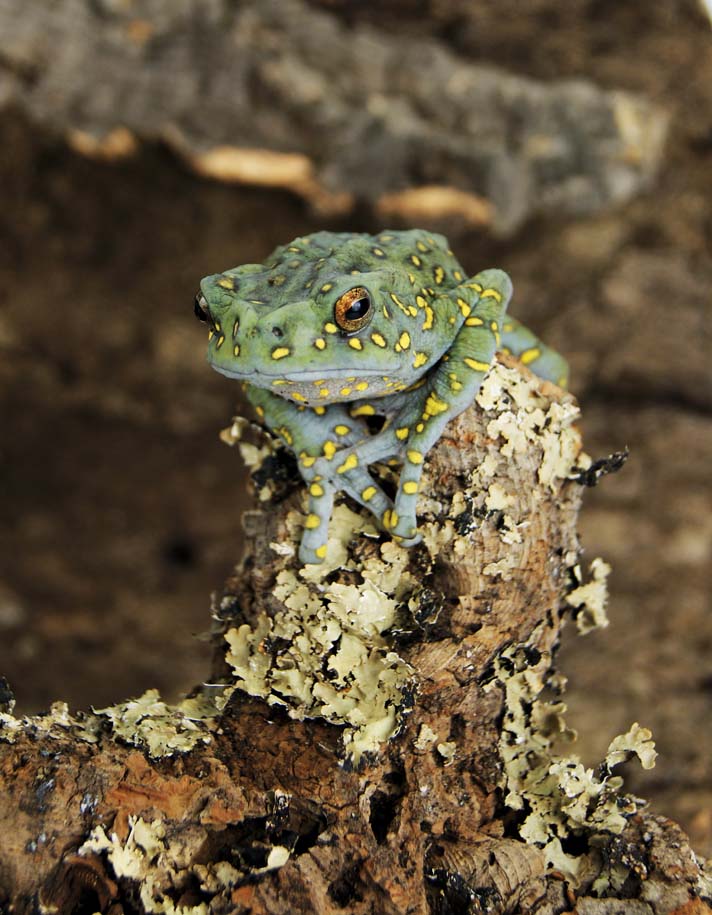
TRISH EDDIE; AMANDA POTTER
Female yellow-spotted climbing toad.
Female yellow-spotted climbing toads are one of the most attractive toads out there. They are big, easily 3½ to 4 inches long from snout to vent. As mentioned, they have a background color of blue to sea foam green, and are covered with yellow spots or lines. They differ so much in appearance from males, that the two sexes were once imported as entirely separate species.
Our third toad didn’t seem to fit either description. It was larger than the males, but not huge. It was, like them, fairly dark in color and had yellowish bands on its legs, but it lacked the numerous yellow spots for which the species is named. After several months in our care, the toad did something unexpected: it called! So we had three males, and it was time to track down some ladies if our YSCT project was going to continue.
Fortunately, we were able to acquire four additional males and two females in the summer of 2013.
Breeding The Yellow-Spotted Climbing Toad
Our six new arrivals spent three months in quarantine upon arriving at the facility. After testing negative for chytrid and ranavirus, as well as passing clean fecals, the newcomers joined the other three in the room we had begun calling the Toad Zone. It was November in Michigan, and while the winter winds howled and snow made outdoor life miserable, I daydreamed of warm, tropical Malaysia, a magical place where giant, colorful toads came down from the trees to make more toads in swiftly flowing streams. After reviewing the literature and looking at weather patterns, we determined that the spring of 2014 was likely going to provide us with our first real opportunity to breed Pedostibes hosii.
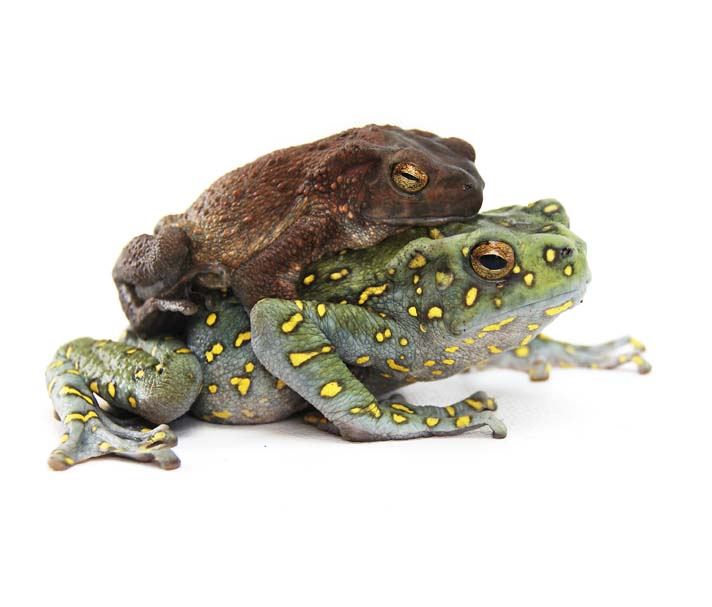
Trish Eddie; Amanda Potter
A male sits atop the female in amplexus.
Come February, we doubled the misting durations and increased the amount of food being offered to the toads. They all bulked up, and the two new females began to take on a swollen appearance. This was not a “swollen after Thanksgiving dinner” situation, either — they were swollen with eggs!
Into the rain chamber the largest female and two willing male suitors went. The rain chamber was a basic affair: a medium/tall (24x18x24) Exo Terra Natural Terrarium, with an overflow drilled into the front panel below the doors that drained into a nearby sink. Rain was provided by a PVC bar that was zip-tied to the top of the cage. It had many small holes drilled into it, and was hooked up to a pump and a tub filled with 175 gallons of reverse osmosis water remineralized with Josh’s Frogs’ R/O Rx.
With this setup, when the “rain” ran at night for eight hours, fresh water would flow through the tank and out to the sink, creating a clean environment for the toads. Several cork tubes were provided for perching areas, and some artificial plants were placed in the water so the mom-to-be would have something to wrap her eggs around.
Several days passed, and nothing happened. The obviously egg-laden female initially ignored the honking pleas of the males, before finally giving in. Amplexus was observed for a few days, then we left town for NARBC, and while there, we got the call that eggs had been laid, as mentioned at the beginning of this article.
The eggs were observed closely for several days. Adults and any unneccesary cage furniture were removed from the rain chamber, with only a few artificial plants left in place, coated with strands of eggs. The rain was set to run for 15 minutes every four hours in order to maintain water quality.
After 48 hours, about three-quarters of the eggs had hatched, resulting in thousands of tadpoles! For the first several days, they remained at the bottom of the tank, seemingly unable to move. Unfertilized eggs began to disintegrate, and despite our efforts to remove as many as we could with a turkey baster, the water became fouled and we lost some tadpoles.
Yellow-Spotted Climbing Toad Tadpoles
By day five, the tadpoles suddenly became mobile, spending much of their time on the sides of the rain chamber. Close observation revealed a rasping mouth type, which led us to suspect they fed on algae or biofilm (the slimy coating of microorganisms that coats underwater surfaces). We began offering Sera Micron (a powdered growth food) several times a day, and increased the water changes. Air stones were added to increase oxygen content of the water, as well as to help the food remain suspended for longer periods. Inspections for dead tadpoles were conducted several times a day; if any were found, they were removed using a turkey baster.
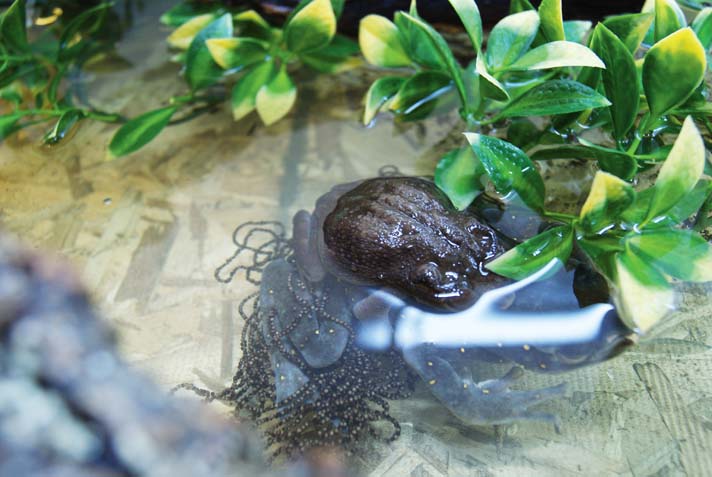
Trish Eddie; Amanda Potter
The male and female with toad eggs.
As the tadpoles quickly grew, it became obvious that the rain chamber was not going to be anywhere near large enough to house the hundreds of remaining larvae. From what little data we could gather, we learned that climbing toads laid eggs in streams or jungle ponds. We had plenty of tadpoles, so we decided to hedge our bets and construct multiple rearing tanks to see what worked the best for our wards. Three 40-gallon breeder aquaria were set up. One — our pond tank — had sponge filters, lots of Indian almond leaves, and Java moss; another — our stream tank — utilized a pump that created a strong current, and the third was our standard tadpole tank, with sponge filters, a 1-inch gravel bed, and an undergravel filter.
Within days, tadpoles in the stream tank were noticeably more active and spread more evenly throughout the tank. Tadpoles in the other tanks were grouped closer to the air stones. We interpreted this as evidence that the tadpoles required a more highly oxygenated environment, more than a stagnant pool or pond could provide. This was later confirmed by discussion with a field researcher who was familiar with the yellow-spotted climbing toad.
As the tadpoles grew, they quickly began to overpopulate the aquaria. Small die-offs were witnessed in the two less-oxygenated tanks. More airstones and sponge filters were added, and about half the tadpoles were transferred to a 180-gallon cattle trough, filtered by a makeshift overflow filter constructed from a 500-gallons-per-hour pump and a bucket.
As the tadpoles grew, so did their appetites. In addition to Sera Micron, we added Repashy Savory Stew and Shrimp Souffle to the menu, as well as what would eventually become Josh’s Frogs Tree Frog and Toad Tadpole Food. Food was offered multiple times a day. A couple hours after feeding, excess food was removed and a large water change was performed. Yellow-spotted climbing toad tadpoles are demanding and require lots of food, many water changes, and plenty of oxygen to stay healthy.
Yellow-Spotted Climbing Toad Toadlets
About a month after hatching, many of the tadpoles began to show the tiny beginnings of rear legs. A week later, many had visible front legs, too! On April 29, 2014, our first toadlet hit land. Soon after, many more followed, and we had 15 to 30 toads leaving the water every day.
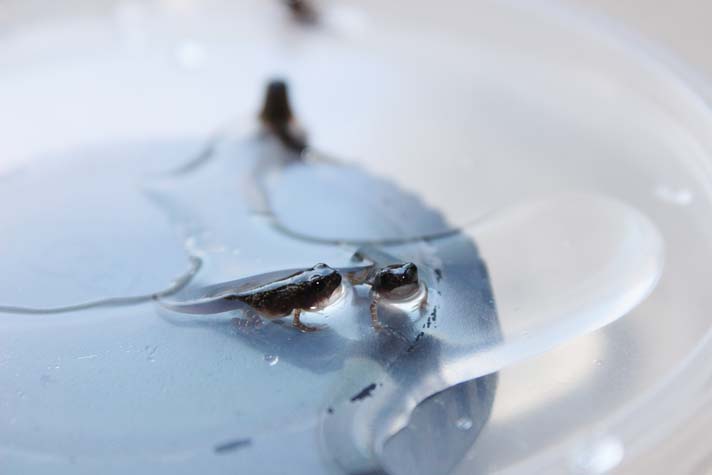
Trish Eddie; Amanda Potter
Within 40 hours of leaving the water, toadlets the size of fruit flies began to feed on newly hatched springtails.
As soon as four legs were visible, we began removing the toadlets before they left the water. By pulling them early, we were able to provide them with more controlled conditions for safer morphing. Toadlets were set up in 1-gallon tubs with damp paper towel for substrate, and a handful of wet sphagnum moss as a hide. Newly pulled toads were placed in a deli cup lid containing water located in the middle of the tub. As they morphed, they could easily leave the water.
Within 40 hours of leaving the water, toadlets the size of fruit flies began to feed on newly hatched springtails. As soon as their tails disappeared, the young toads eagerly began gulping down springtails and Melanogaster fruit flies. After a week, they began to consume pinhead crickets. By the end of May, the largest of the captive-bred toads were eating 1/8-inch banded crickets with gusto. All prey items were dusted with the same supplements as previously described for the adults, and offered multiple times a day. The paper towel substrate was changed twice a week.
By the middle of July, the 1-inch-long toads were eating ¼-inch crickets. We moved them to large Exo Terra Breeding Boxes, on a thin layer of coco fiber (later changed to Frog Foam), with a handful of sphagnum moss and a couple magnolia leaves for hides. We misted the enclosures and fed approximately two to four ¼-inch crickets once a day to the growing toadlets.
In August 2014, we had about 400 healthy toadlets and a plan for the following year’s breeding season. In 2015, we produced nearly 1,000 toadlets. The Pedostibes hosii we held back from our first breeding success began to show adult coloration at 8 months of age, and by the time the 2015 clutch was laid, they were well over 2½ inches in length and almost fully colored up. As of August 2016, these animals (now about 2½ years old) are fully adult size and seem primed to breed in 2017.
Hundreds of frog keepers have experienced the joy of keeping yellow-spotted climbing toads since our initial offering of captive-bred specimens in 2014. These toads are hardy when captive bred, and as easy to keep as a White’s tree frog! And with captive-breeding efforts ongoing, these amazing arboreal amphibians are more available than ever before.
Zach Brinks has been keeping and breeding various reptiles and amphibians for over 20 years. Heading the animal breeding operations at Josh’s Frogs (JoshsFrogs.com), he oversees the breeding of dozens of different species of anura. With a BS in biology from Michigan State University, Zach works to produce healthy, captive-bred specimens and to reduce the demand for wild-caught animals.

